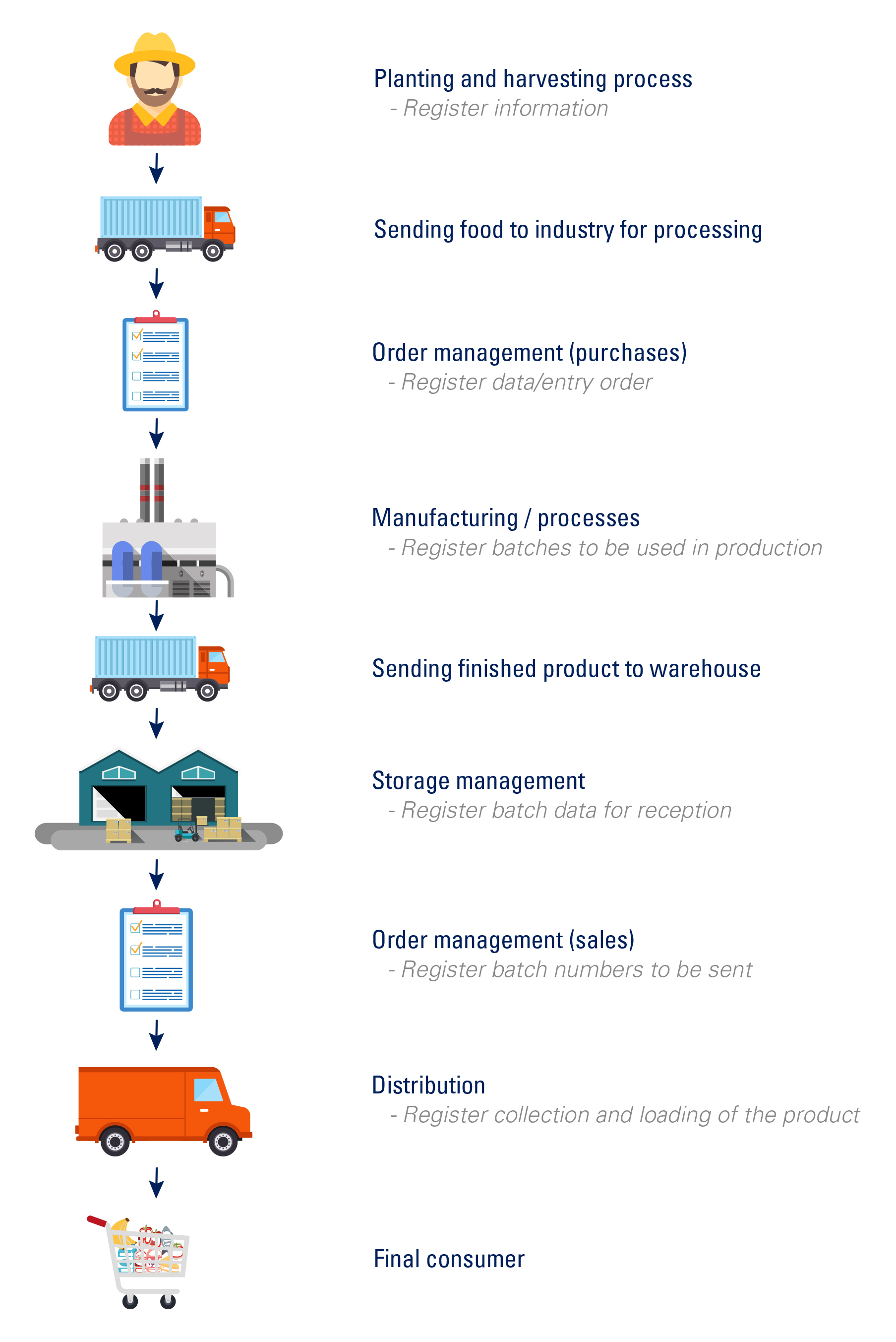What is a supply chain?
To be able to define an Intelligent Supply Chain, we must first understand what a Supply Chain is. This is the process that the product follows from its “birth” to its delivery to the final customer. That is, since it is a raw material, passing through the process in which it transforms, until it becomes a final product and gets to the customer’s hands. The process begins before the raw material arrives at the factory. As an example, we will name a company “X” of canned food. Its raw materials are agro-industry products such as tomatoes, potatoes, carrots, chili peppers, onions, etc. The supply chain starts with the request of products or raw materials to growing centers. Once the raw material arrives at the factory, its transformation process begins until it becomes the final product. In this case, canned food.
It is important to emphasize that there are different identifications for each process and product, this is where the term traceability appears. Most of the companies hardly contact us asking for a solution to their supply chain, as it is a very broad term that covers several points. However, they do look for us for something that will directly impact and improve their Supply Chain in a way. For example, the ask for help with the intelligent identification of their primary, secondary or pallet packaging, to improve a process, reduce the costs, reduce maintenance and shorten line stop times or simply, optimize and automate the process. For all this, UBS perfectly meets the requirements for each type of packaging. Starting with the primary, which is like the product’s “birth”. Then the cans go to the secondary packaging (box or pack) that must have an identification, because it also undergoes the packing process becoming tertiary packing (pallet).

What part of the supply chain process does UBS participate in?
Mainly in the identification, although it might seem a small contribution, failures can have very large consequences. A poor identification loses the final consumer’s trust. Let's think about a medicine without expiration date. Hardly anyone would consume it. Or in a wholesaler that sells the products cased in boxes or packages. If the boxes are not correctly identified or the information is not readable, it could mean losing a sale or a customer. But the most alarming case is a bad "dispatch" of a product or raw material. Miss identification can involve large costs, or worse, cause health damage to people for wrongly supplying a product.

Formerly, we identified products with stamps and labels. The whole process was very manual. Nowadays, given the great technological advance in machines, speeds and production rates, it would require a lot of labor to be able to identify everything. Not only that, even if having the necessary human resources, the process would be very slow, causing delays and errors. In addition to this, the products in question must meet rules and standards of identification, labeling and coding for national and international sales. Therefore, it is necessary that the identification works optimally, making sure of the following points:
- Correct identification.
- Reaching the final customer with a correct identification (unit product, box or pallet) that enables to know the origin, production date, who is the manufacturer and how was it produced.
- Providing traceability to the company to feed their data.
Consider each point separately, the risk of a misidentified product can have consequences such as fines or additional expenses generated in the product recovery process. Some time ago, a customer commented that for each package of drinks that was poorly labeled or that was received without a label, the company had to pay a fine of approximately $5.00. Now let's think of 1, 2 or 3 trucks carrying 33 pallets each. Every pallet with 100 packages, in total there are approximately 300 packages per truck (reference to know the volume of fines). If a machine fails, it is not working or it is simply too easy for any operator with no specific permission to turn it off, the costs of getting back those packages would be very high. In some cases, it could be higher than the cost of destroying them and starting again. Therefore, when a printer or a print & apply machine has an error, we answer to the customer's call immediately. We are aware of the costs that we can save them.
pallet-labeling-equipment-apl-60-series.jpg)
Another example of this would be a soft drink company, which for some reason has an incident during filling, sealing or packaging. Imagine that water is supplied instead of a soft drink for only 3 minutes. The consequences for the company are important, as it could impact the brand image since today, through social media, it is very easy to put a company in the spotlight.
With our solution this would have worked out differently: The company detected the error. It was tracked thanks to the data UBS provided to the ERP, WMS, etc. Everything that had been labeled in the last 20 minutes (giving space to the delay times), did not reach the final customer because the label had crucial information as the exact time when the mistake was produced. This issue ended up being only an issue and did not damage the company’s image.
In addition to participating in the identification of packaging, we develop integration interfaces. We make our machines more intelligent, receiving inputs from the customer’s system and sending information back to the ERP, WMS, etc.
In order for the chain to continue working correctly, the machine, APL or Inkjet sends back to the client quality information with the characteristics, letting the system know what is being produced (talking about end-of-line labels). This is known as production closure, liquidation or as it is call it in Brazil, Apontamento do Final da Linha.
Previously, these closures were made in the fillers, or in some other machines within the process. As in bottling companies, for example. But the bottles still go a long way after being dosed: putting caps, counting, collecting, packaging and palletizing. It is impossible to avoid incidents such as the fall of a pallet, a destroyed bottle, a broken secondary packaging, etc. Therefore, our automatic pallet labelers have been widely accepted, since we are at the end of the entire process described above.
We have taken the process beyond hardware by providing intelligence to our equipment. After labeling, the probability of damage is much lower, since the product has already traveled all the way and it is in the final phase of storage. The risk of incidents is reduced to accidents such as: shock of a forklift, falls, etc. There are even dynamic warehouse systems that allow the pallet to go straight to its final position, greatly reducing the incidents in the way. Thus, with UBS at the end of the line applying data and also returning information, enables the customer to make reports by day, by hour, by shift, by lot or by operator so that the same client can generate valuable information with the data UBS sends.
This automation can also prevent ant theft. For example, let's go back to the bottler with 19 production lines. The numbers did not add up, comparing production versus what actually comes out. There were missing pallets (removing pallets is obviously illegal but highly profitable). The company needed to guarantee what was happening. For this, it was necessary that all the pallet labels work automatically, a 99.9% machine efficiency guarantee was necessary.
We included a full-time trained technician, 100% formed from the UBS DNA, to guarantee the optimum performance of the machines. This measure and a dynamic warehouse made the incidence levels drop.
Usually, in product identification, there are specific problems. Starting from a good identification of the products is the smart way to strengthen your supply chain. Always adapting to the needs of each client. Attending from the most basic labeling and coding needs, to the most advanced developments, in order to integrate their UBS equipment in any system required.
Interview with Engineer Ricardo Chávez
LATAM Director in United Barcode Systems
More than 15 years of experience in the sector

